Myths about besieged Leningrad
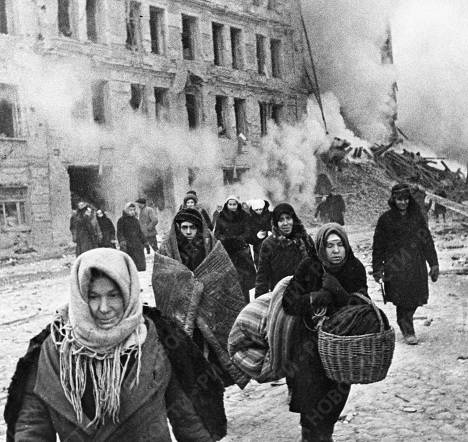
The siege of Leningrad by the Nazis did not remain overlooked by the "whipers" of the Red Empire. There were even opinions that it was necessary to give the second capital to the Wehrmacht and thereby save hundreds of thousands of lives of ordinary people.
Although it is clear that the surrender of Leningrad would have catastrophically worsened the situation on the Soviet-German front, Army Group North would be freed to assist in the storming of Moscow. In terms of psychology, to give the second capital without a fight - to undermine the morale of all Soviet citizens.
And yet, “humanists” are lying consciously or ill-acquainted with history World War II - in Berlin they planned to not only take hail on the Neva, but also completely destroy it, destroying its inhabitants.
So, 8 July 1941, Chief of Staff of the Ground Forces Command F. Halder wrote in his diary: “The Fuhrer’s unshakable decision to level Moscow and Leningrad with the land in order to completely get rid of the population of these cities, which otherwise we will be forced to feed during the winter ".
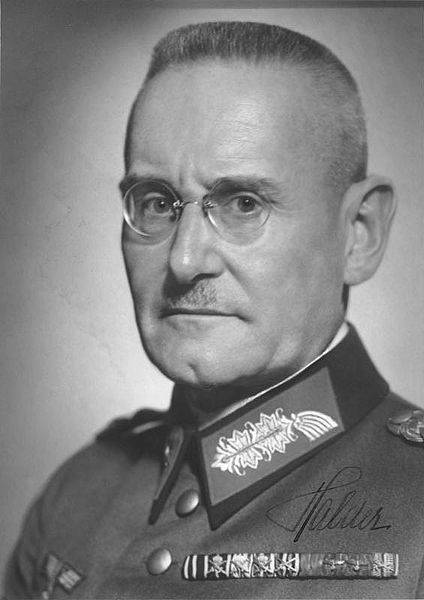
Halder, Franz.
16 July 1941 of the Führer’s headquarters hosted a meeting of top leaders of the Reich, the protocol states that Finland claims the Leningrad Region, so Hitler wants to destroy Leningrad and then give the empty land to the Finns.
On September 21, 1941, the defense department of the Supreme High Command of the Armed Forces of Germany submitted an analytical report in which it considered possible options for action with respect to Leningrad, and ultimately concluded that the best option would be to completely surround the city, destroy it with artillery and aviation. After artillery and airstrikes, famines release unarmed people, in the spring to finish off the garrison and transfer the ruins of Helsinki. Naturally, the Wehrmacht was not going to feed the people "released" in the winter.
October 7, Chief of the Operational Department of the Ground Forces Command, Yodl told Field Marshal Brauchitsch: "The capitulation of Leningrad, and later of Moscow, should not be accepted even if it were offered by the enemy ... One should expect great fears of epidemics ... their population cannot be fed at the expense of the German homeland ... ".
To summarize: the Germans, in the case of the surrender of the city, did not plan to “save” the civilian population of Leningrad, it would simply have died of starvation.
On the part of Finland, the Leningraders also did not have to wait for anything good. In early September, 1941 from the Finnish General Staff reported to the Finnish Foreign Ministry that the occupation of Leningrad by the Finnish troops was impossible because there was nothing to feed the civilians. 11 September 1941, Finnish President Ryti declared to the German envoy: "Leningrad must be eliminated, like a big city."
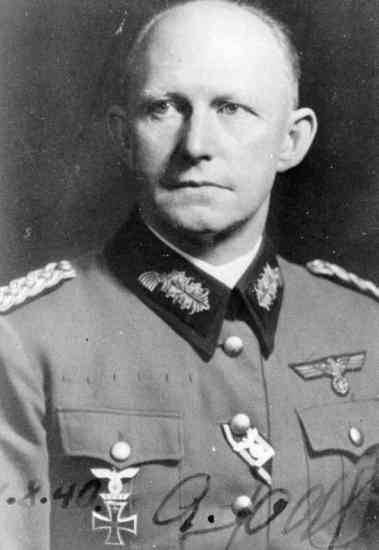
Head of the Operations Division of the High Command Armed Forces A. Jodl.
Has Finland planned a war with the USSR in 1941?
Another myth is that the peace-loving Finns did not plan to attack the USSR in June 1941. And only the bombing of the Soviet aviation 25 Jun forced them to join the Third Reich. But even after the start of the war, the Finnish army, which was led by the “royal officer” Karl Mannerheim, did not attack the old Soviet-Finnish border, and thus Finland saved Leningrad, which otherwise would have fallen.
- In August, 1940, the German military attache in Helsinki Rössing reported that the Finnish armed forces (16 divisions) were being strengthened with the help of Germany, negotiations are underway on the passage of the Reich mountain divisions through Finland.
- 12 September 1940 in Finland signed an agreement on the passage of German troops through Finnish territory. September 21 arrived the first transports with troops and weapons.
- In mid-December, Halder was visited by the Finnish military (Major General Paavo Talvela and military attache Walter Horn), and questions were discussed about the timing of the Finnish offensive on both sides of Lake Ladoga to Leningrad.
- January 30 1941 was secretly arrived at the Reich by the Chief of the Finnish General Staff, Eric Heinriks. He said that the mobilization would require 9 days, the main attack would be in the direction of Leningrad on both sides of Lake Ladoga - 5 divisions from the south and 3 divisions from the north. After the visit of the head of the Finnish General Staff, the Finnish envoy Toivo Kivimaki on behalf of Finland officially informed Ribbentrop that Finland would be an ally of Germany.
- On May 24, the head of the Finnish General Staff and four other representatives of the Finnish armed forces arrived in the Reich to finalize joint plans for a war against the USSR. On the part of the Third Reich, negotiations were conducted by V. Keitel, A. Jodl and F. Halder. 25-28 May Finns and Germans finally agreed on common plans: the Finnish armed forces were supposed to strike two weeks after the German invasion. For the war against the USSR, Finland created two operational German-Finnish groups of troops. 1-I was divided into three separate groups, they had to attack Murmansk, Kandalaksha, Loukhi - the operation "Polar fox". The 2 group dealt two blows: the Finnish Karelian Army with the German 163 Infantry Division was to attack Petrozavodsk; the Finnish Southeastern Army, interacting with the German 18 Army, is to attack Leningrad. The Finnish army also had to conduct an operation to seize the Hanko peninsula.
- 17 June 1941, Finland withdrew from the League of Nations, 18-th general mobilization began. 18 th German troops in Finland began to move to the Soviet border and took positions to strike. A meeting was held in the Finnish General Staff, where the heads of the operational departments of the corps headquarters were informed about the joint plans of Germany and Finland. 19-th was given a preliminary order of the offensive.
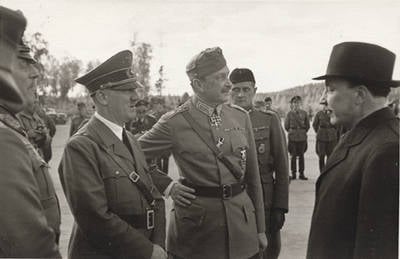
Hitler’s meeting with Marshal Mannerheim and President Ryti; Imatra, Finland, 200 km. northwest of Leningrad, 1942.
On the “noble” Carla Mannerheim
In preparation for the war on the side of the Reich, the Finnish elite planned not only to return the lands lost as a result of the 1939-1940 war, but also to receive territories that did not previously belong to Finland.
The Finnish ambassador to Germany, T. Kivimäki, asked the president to prepare scientific calculations that would prove to the Germans that East Karelia belongs to Finland. Professor Jalmari Jaakkola prepared the material “Eastern Question of Finland”. At the same time, K. Mannerheim was ordered to prepare the calculations, from a military point of view, about the eastern border. In total, 5 variants of the new border were prepared, the most acceptable option was considered: White Sea - Onega Lake - Lake Ladoga - Neva River.
On June 21 (before the German attack), the Finns landed five thousand troops on the demilitarized Aland Islands, arresting the Soviet consulate staff. In the evening, 21, Finnish submarines, laid mines off the Estonian coast, the submarine commanders had orders to attack Soviet ships if they had "worthy targets."
22 th Finnish sabotage detachment tried to blow up the White Sea-Baltic Canal locks. On the same day, Hitler declared that in the North the Finns were fighting in alliance with the Germans.
On June 23, German planes dropped sea mines into the fairway between Leningrad and Kronstadt, boarded Finnish airfields.
On June 25, in order to protect Leningrad from raids from Finland, the Soviet Air Force struck 18 on Finnish and Norwegian airfields, where German aircraft were based. This event became the official pretext to declare war on the USSR. 30 July 1941, the British Air Force struck the city of Petsamo, German forces were stationed there - Helsinki limited itself to breaking off diplomatic relations.
By 1 September 1941, the Finnish army was able to reach the old Soviet-Finnish border on the Karelian Isthmus and stormed it for several days. The Finns were able to take the Old Beloostrov and several other settlements on the Sestra River and one of the foremost dots of the Karelian fortified area. At the same time, the Karelian army was bypassing Lake Ladoga to close the outer ring of the blockade of Leningrad.
In the hope that Leningrad would soon fall, a solemn speech was even prepared for the president. But the hopes of the Finns were dispelled.
With its fierce resistance, the Red Army thwarted all the plans of the Germans and Finns. Relying on the Karelian UR, the Red Army soldiers repulsed the onslaught of the Finnish army, and on September 5 they beat off Old Beloostrov. Finnish soldiers began to massively refuse to attack the Soviet fortifications. As a result, Karl Mannerheim was forced to abandon plans for further offensive and go on the defensive. The myth of the "noble" Mannerheim was invented to conceal the criminal plans of the Finnish elite and bring to oblivion the feat of soldiers, sailors, commanders of the Red Army.
Marshal Carl Gustav Emil Mannerheim and President Risto Ryti inspect troops at Enso (now Svetogorsk). 4 June 1944
Sources of:
Baryshnikov N. I. The Siege of Leningrad and Finland. 1941-1945. SPb., Helsinki, 2002.
Halder F. Military Diary. M., 1971.
M. I. Frolov. Adolf Hitler: "The poisonous nest of Petersburg ... must disappear from the face of the Earth." Military history magazine. 2001, No. 9.
Shirokograd A. B. Northern wars of Russia. M., Minsk, 2001.
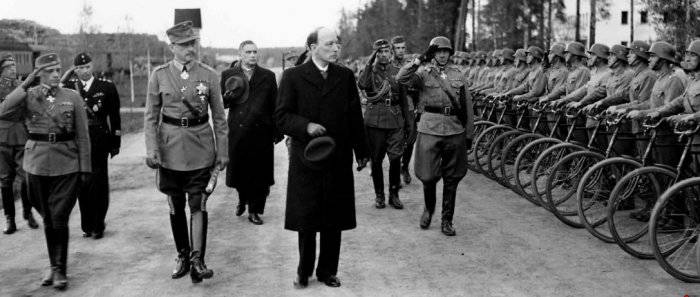
Information